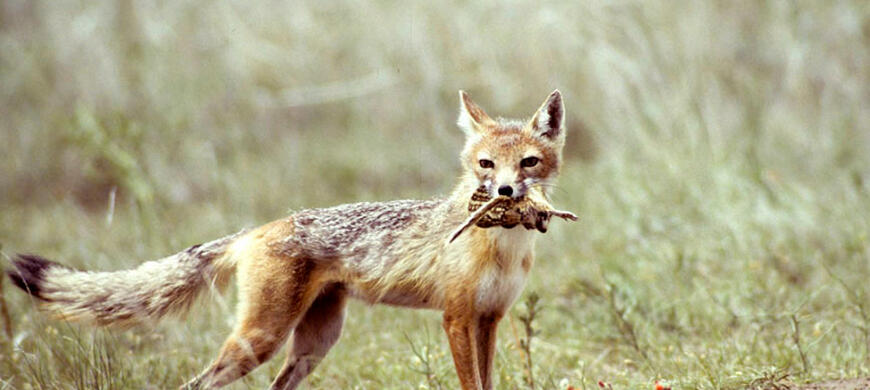Swift Fox

The cat-sized swift fox ( Vulpes velox) is a representative of the short- and mid-grass prairie ecosystems of the United States and Canada. Considered the least wary of the Kansas canids, swift foxes were extremely susceptible to extermination efforts aimed at larger predators, and were either very scarce or extinct from much of their historic range by the 1950s. However, as predator control activities tapered off, swift fox populations gradually increased. Today, swift foxes have reoccupied much of the western portion of their original range. Kansas, Colorado, and Wyoming now support what is considered the core of the U.S. swift fox population.
In Kansas, the swift fox’s current range includes the western three to four tiers of counties. Although once thought to rely on areas dominated by rangeland, swift foxes can survive in highly agricultural landscapes as well. Habitat requirements include flat or rolling landscapes with short vegetation allowing for visual predator avoidance, and soil types suitable for digging dens. The buff and grayish coloration and small size (about 5 pounds) of the swift fox make it easily distinguishable from other Kansas foxes. Quick and agile, the swift fox’s name refers to its fleetness of foot, which it uses to capture prey and escape from predators. Primary prey items include jackrabbits and cottontails. Mice, prairie dogs, shrews, birds, carrion, grasshoppers and other insects, and some plant materials including sunflower seeds are also consumed.
Swift foxes are the most den-dependent of North American canids, and rely on the protection of dens year-round. Though capable of digging their own, they will also excavate the dens of smaller animals. Dens provide shelter from extreme weather conditions, help to conserve water in an arid environment, and offer protection from predators for both adults and pups. Pups are born around April, usually three to five per litter, and develop quickly. They are full grown by four to five months of age, and disperse a short distance from their parents’ home range in their first fall. Home range sizes are commonly 4-5 square miles.
Golden eagles, great-horned owls, bobcats, badgers, and red foxes all occasionally prey on swift foxes, but it is the coyote that is responsible for the majority of the annual mortality in most swift fox populations. Swift foxes are also susceptible to roadkill. Annual mortality rates of swift foxes are usually high, sometimes more than 50 percent, and it is rare for a swift fox to live past three or four years in the wild.
The swift fox has been an unimportant species to the fur trade in Kansas. Since a pelt tagging program was initiated by KDWP in 1994, fewer than 50 per year have been tagged. Despite this, monitoring techniques indicate that swift fox populations are stable in Kansas, and are not unlike what they were in the 1980s when harvest estimates were in the hundreds – the difference now being fewer coyote trappers in the field. Swift foxes are easily trapped, with almost 60 percent of the harvest taken in foothold traps since the tagging program began.








